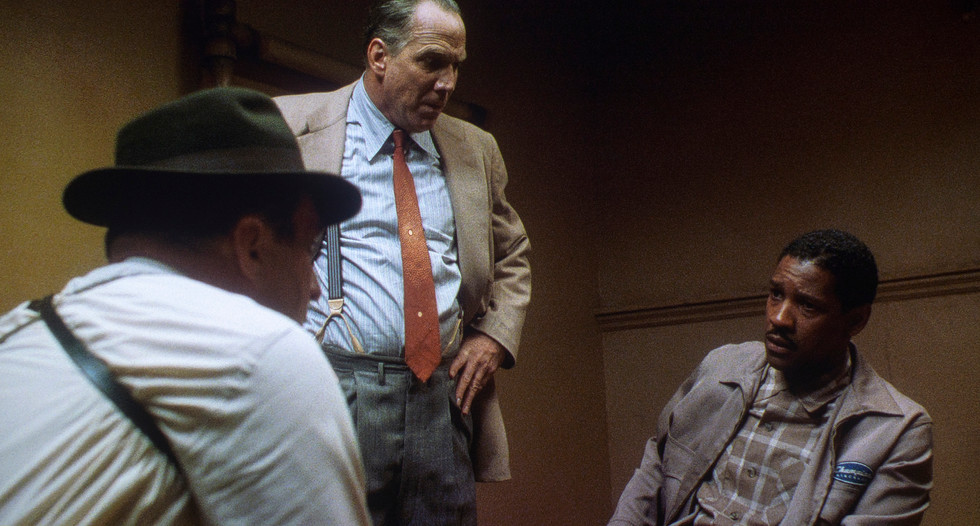Criterion checks all the boxes with ‘Devil in a Blue Dress’
- Craig Shapiro & Bill Kelley III

- Jul 20, 2022
- 5 min read
Updated: Jul 22, 2022
4K ULTRA HD REVIEW / HDR FRAME SHOTS

Denzel Washington plays ex-GI Ezekiel “Easy” Rawlins, who accepts an offer to find a missing white woman named Daphne Monet.
(Click an image to scroll the larger versions)
“DEVIL IN A BLUE DRESS: THE CRITERION COLLECTION”
4K Ultra HD; 1995; R for violence, sexuality and language Best extras: New conversations with author Walter Mosely and novelist/screenwriter Attica Locke, and director/writer Carl Franklin and co-star Don Cheadle
DON’T BE QUICK to file “Devil in a Blue Dress” under “Film Noir” or even “Neo Noir.” That isn’t what Walter Mosely had in mind when he introduced the world to Ezekiel “Easy” Rawlins in his acclaimed 1990 debut novel, though he does tell novelist/screenwriter Attica Locke that he was about half finished when he realized that it was “kind of like a mystery.” And it isn’t what director/writer Carl Franklin (1992’s superb “One False Move”) had in mind when he adapted Mosley’s bestseller. In another must-see sit-down recorded for this Criterion release, he tells co-star Don Cheadle (“Hotel Rawanda,” 2004, the “Iron Man” sequels, 2010, 2013) that he saw it as a crime drama, adding that to “some extent, it defies noir.” Instead, Mosley and Franklin were focused on the broader context—that would be social realism and, specifically, what life was like for an African-American in 1948 Los Angeles. Rotten with overt, ingrained racism, it wasn’t that different for African-Americans everywhere today.
(1) “Devil in a Blue Dress” premiered at the Toronto International Film Festival on Sept. 16, 1995. (2) Rawlins is told by his boss that he’s being replaced by a guy willing to work two shifts. (3) Vibrant Central Avenue was the heart of the African-American community in Los Angeles, with an active R&B and jazz scene. (4&5) At a friend’s bar, Rawlins scans the want-ads for a new job. (6) Tom Sizemore plays the sinister Dewitt Albright, who offers Rawlins a job to find Monet.
Played by Denzel Washington (insert title of favorite movie) with equal parts cocky charm and practiced caution, Easy, who left Houston for the Promised Land, is living the American Dream. He’s the proud owner of a neat bungalow, but he’s been unjustly laid off from his job as an airplane mechanic and needs to pay the mortgage. Although he senses where it will lead him, and vowing not to lose his home, he accepts an offer from Dewitt Albright (Tom Sizemore, “Saving Private Ryan,” 1998), a sinister opportunist who hires him to find a missing white woman named Daphne Monet (Jennifer Beals, “Flashdance,” 1983). Albright tells Easy that she favors the jazz clubs on Central Avenue, then the hub of African-American life, and has “a taste for dark meat.” Two years ago, Washington told the American Film Institute that one of his favorite memories about shooting “Blue Dress” was its sense of place. It’s no wonder why: The clubs and crowded streets pulse with electricity as Easy makes the rounds. Those rounds, though, soon take him up the ladder of L.A. politics, where he crosses paths with Todd Carter (Terry Kinney, TV’s “Oz,” 1997-2003), a connected, rich white man who suddenly dropped out of the mayor’s race, and Matthew Terell (Maury Chaykin, “Dances with Wolves,” 1990), a Grade A slime ball who looks like a shoo-in. Both have a connection to Monet, who has a secret of her own. And that’s when Easy realizes he’s in over his head—and that’s when he calls Mouse Alexander, his gold-toothed, gun-happy running mate from Houston. You want electricity? Cheadle, in one of the great breakthrough performances of the ‘90s, practically steals the movie. Before it’s all over … On second thought, there’ll be no spoilers here.
(1) Jernard Burks plays Dupree Bouchard, Easy’s former co-worker, and Lisa Nicole Carson is his girlfriend, Coretta James. Both are hiding something about the missing woman, a secret that proves deadly. (2) Easy’s tidy bungalow is his pride and joy, and he needs money for the mortgage. (3-4) Rawlins is questioned by LAPD detectives about a murder, then tries to sleep off a beating from one of them. (5&6) He’s awakened by a phone call from Daphne Monet (Jennifer Beals), who asks him to take her to the home of her ex-boyfriend. (7&8) When Rawlins returns home, Albright and his henchmen are waiting.
VIDEO
The new 4K scan of the original camera negative (1.85:1 aspect ratio) was handled by Sony Pictures technology specialist James Owsley using the Scanity film scanner. The 4K master extracts a good, consistent dose of natural film grain that is most evident in the dark interiors and nighttime scenes. Overall clarity is also very good on the enclosed Blu-ray. It was sourced from the same master, but the 4K disc takes it to a much higher level, particularly in the deep wide shots and close-ups from cinematographer Tak Fujimoto (“The Silence of the Lambs,” 1991).
Colorist David Bernstein of Roundabout Entertainment used standard HDR10 for the HDR grading, while the more advanced Dolby Vision provides excellent shadow detail and keeps the highlights in check. The slightly darker 4K disc suits the noir-ish storyline, the earthy color palette is rich and saturated and facial toning is excellent.
AUDIO
Remastered from the original six-track magnetic source, the encoded six-channel DTS-HD Master delivers a front- and center-driven soundtrack. Dialogue is always clear, gun blasts are nicely distributed to surround speakers and the relaxed score courtesy of Elmer Bernstein (“The Magnificent Seven,” 1960) and ‘40s-era standards by the likes of T-Bone Walker, Jimmy Witherspoon, Duke Ellington, and Thelonious Monk sparkle.
(1) Terry Kinney is Todd Carter, the ultra-rich businessman whose ties to Monet force him to drop out of the mayor’s race. (2) Rawlins asks a waiter about the whereabouts of a local hood who hijacks trucks hauling liquor and sells it on Central Avenue. (3) Easy and Mouse Alexander (Don Cheadle), his gun-happy wingman from Houston, question Junior Fornay (David Fonteno) about another murder. (4) Rawlins and Mouse drive to Compton to see Bouchard’s sister. (5) Drunk and half asleep, Mouse pulls a gun on his buddy. (6&7) Monet makes another unannounced call on Easy only to be nabbed by Albright. Rawlins is in hot pursuit.
EXTRAS
We just can’t say enough about the conversations with Mosley and Locke and Franklin and Cheadle.
Did you know that Easy and Mouse were paired in a short story titled “House Party” that predates “Devil in a Blue Dress”? Mosely talks about it, his career-forming experiences growing up in Houston’s Fifth Ward and Los Angeles and how reading Dashiell Hammet, Raymond Chandler, James M. Cain and noir’s other founding fathers made him a fan of hard-boiled fiction and the kind of hero “who may not be stronger than you physically but will always be stronger than you morally.”
Did you know that Cheadle appeared in “Punk,” Franklin’s AFI thesis film? Their lively conversation runs the gamut, from re-creating Central Avenue to the dark side of Easy’s American Dream, but you have to love this:
Cheadle’s agent had told him that he was born to play Mouse; Cheadle, though, had his doubts and said if Franklin wants him he’ll call. Wouldn’t you know it? Cheadle was waiting to see the ear, nose and throat doctor when in walked Franklin. When the reception area got too crowded, they were asked if they’d mind catching up in another room.
The next day, Cheadle’s agent called and said, “I don’t know what you did, but Carl wants to see you.”
When you’re done with those features, dig into “Crossing the Line,” the in-your-face essay by critic Julian Kimble included in the accompanying booklet. It’s one of Criterion’s best. Other extras include an earlier commentary by Franklin, a conversation with Franklin and film historian Eddie Muller recorded at the 2018 Noir City Film Festival in Chicago and Cheadle’s screen test. Enough. The easy chair and a fresh bowl of popcorn await. Craig Shapiro and Bill Kelley III, High Def Watch producer
(1&2) Easy treasures the tranquility of his home life in Central L.A.


















































Comments